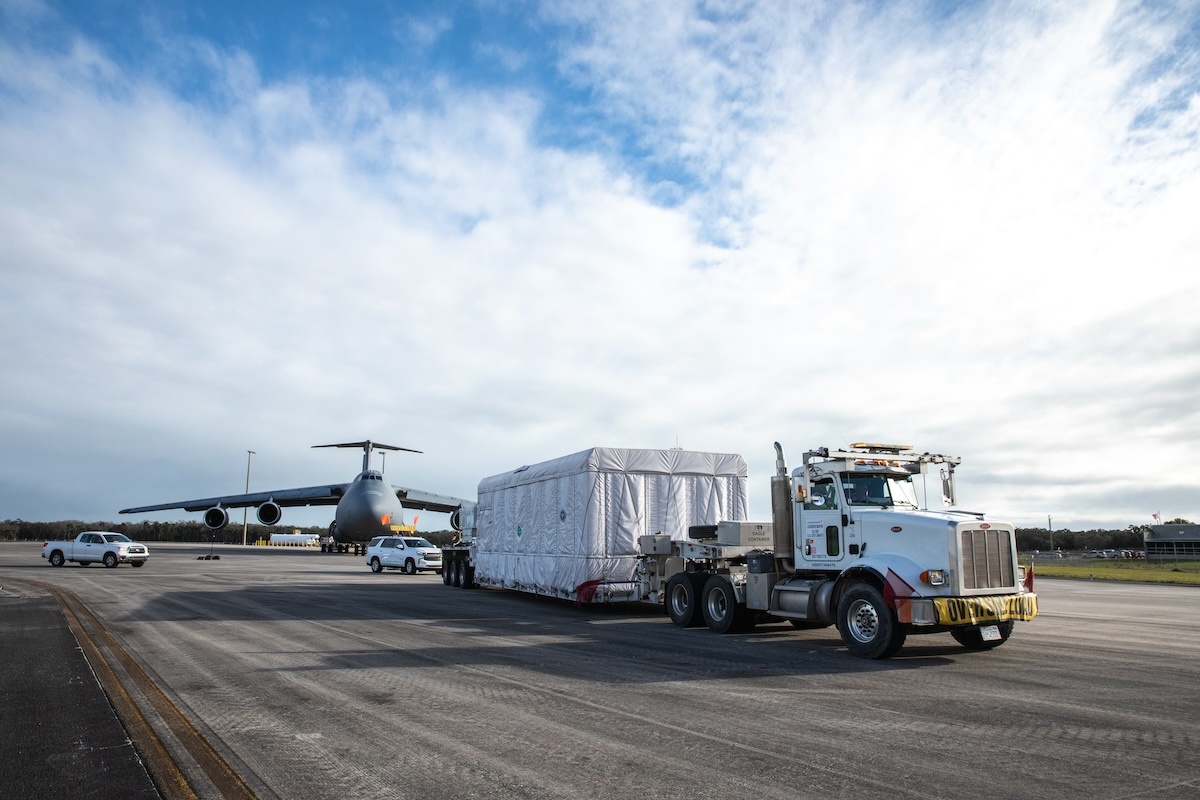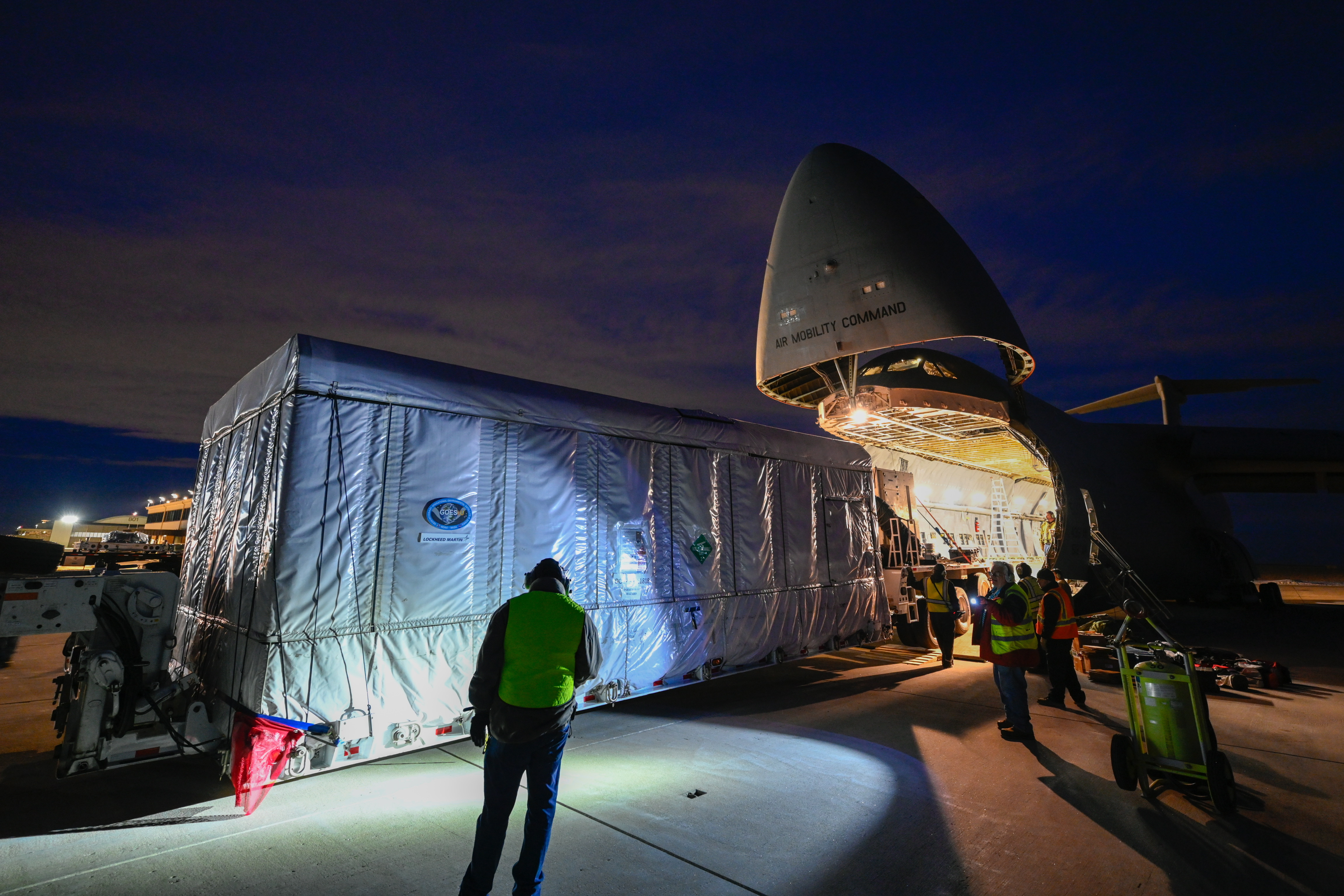25.01.2024
NOAA’s GOES-U Arrives in Florida for Processing Ahead of Launch

The Geostationary Operational Environmental Satellite U (GOES-U), the fourth and final weather-observing and environmental monitoring satellite in NOAA’s GOES-R Series, is now in Florida. The satellite landed on Tuesday, Jan. 23, in a United States Air Force C-5M Super Galaxy cargo plane at the Launch and Landing Facility at NASA’s Kennedy Space Center.
Data from the environmental monitoring satellite constellation enables forecasters to predict, observe, and track local weather events that affect public safety like thunderstorms, hurricanes, wildfires, and solar storms.
Teams spent several hours offloading GOES-U then transferring it to the Astrotech Space Operations facility in nearby Titusville where they will process the spacecraft and perform final checkouts as part of launch preparations.
“GOES is a special circumstance because it’s a series of missions,” said Rex Engelhardt, GOES-U mission manager for NASA’s Launch Services Program. “Knowledge carries over from mission to mission, which makes for a really strong and a very experienced team. To procure and integrate satellites like GOES-U onto commercial rockets, the launch services team understands the requirements of what the satellites are going to need to reach orbit, and that knowledge is critical in bringing additional reliability to the integration process to help ensure success.”
Fueling will be one of the key steps to readying the spacecraft to operate for 15 years in orbit. Technicians will add about 5,000 pounds of hypergolic propellants to GOES-U, then mate the spacecraft to a payload adapter and encapsulate it in a protective payload fairing as part of launch processing.
After testing and fueling are complete, the encapsulated spacecraft will move to the SpaceX hangar at Launch Complex 39A at NASA Kennedy. GOES-U is scheduled to launch no earlier than Tuesday, April 30, aboard a SpaceX Falcon Heavy rocket.
On board GOES-U are seven instruments, including a new Compact Coronagraph-1 (CCOR-1) instrument. As a part of NOAA’s Space Weather Follow On mission, CCOR-1 will observe the Sun’s outermost layer, called the corona, for large explosions of plasma that could produce geomagnetic solar storms. The CCOR-1 instrument will enhance capabilities to provide advance warnings up to four days ahead of these storms that can cause widespread damage to satellites, power grids, and communication and navigation systems.
The GOES-R Series satellites are planned to operate into the 2030s. Looking forward, NOAA is working with NASA to develop the next generation of geostationary satellites, called Geostationary Extended Observations, which will bring new capabilities in support of U.S. weather, ocean, and climate operations beyond the 2030s. NASA will manage the development of the geostationary satellites and launch them for NOAA.
“The GOES-R program demonstrates the tremendous value of NASA’s longstanding collaboration with NOAA,” said Renee Falden, program executive in the Joint Agency Satellite Division at NASA Headquarters in Washington. “We are taking the best qualities of that collaboration forward into the GeoXO program, which will continue NOAA’s key observations from geostationary orbit while generating new data streams for a broad community of users across the country.”
NASA’s Launch Services Program, based at Kennedy, manages the launch service for the GOES-U mission. NASA’s Goddard Space Flight Center oversees the acquisition of the spacecraft and instruments. Lockheed Martin designs, builds, and tests the GOES-R series satellites. L3Harris Technologies provides the primary instrument, the Advanced Baseline Imager, along with the ground system, which includes the antenna system for data reception.
Quelle: NASA
----
Update: 29.01.2024
.
NOAA’s Newest Weather Satellite From Lockheed Martin Arrives In Florida To Begin Launch Preparations
The GOES-U satellite traveled to its final earthly destination on a Lockheed Martin-built C-5M aircraft

GOES-U is the final satellite to round out NOAA’s GOES-R series and is seen here being loaded for transport at Buckley Space Force Base in Aurora, Colorado. Credit: Lockheed Martin.
KENNEDY SPACE CENTER, Florida, Jan. 24, 2024 – The next-generation Geostationary Operational Environmental Satellite (GOES)-U has successfully arrived at Kennedy Space Center, Florida, to begin preparing for its spring launch. It is the final of four satellites in the National Oceanic and Atmospheric Administration (NOAA)’s GOES-R weather satellite series, all built by Lockheed Martin [NYSE: LMT] in Littleton, Colorado.
GOES-U will enable the constellation to continue saving lives and property by ensuring forecasters have access to better-than-ever weather data for many years to come. These satellites provide meteorologists in the U.S. and western hemisphere with crystal-clear images of severe storms, hurricanes, wildfires and other weather hazards earlier than ever before.
“As severe weather patterns increase with our changing climate, unparalleled data from these GOES-R satellites help people stay safe,” said Jagdeep Shergill, Geo Weather programs director, Lockheed Martin. “The GOES-R satellites Lockheed Martin has created have revolutionized weather forecasting, and we’re looking forward to seeing how we can continue to support this capability for future NOAA missions.”
Moving a Spacecraft Across the Country
The small school bus-sized GOES-U needed a spacious ride to Florida, so the team looked no further than the trusty, Lockheed Martin-built C-5M Super Galaxy aircraft. To prepare for shipment, the Lockheed Martin team enclosed the spacecraft in a specialized shipping container that functioned as its own miniature cleanroom.
This enclosure protects GOES-U’s suite of seven state-of-the-art space and Earth weather instruments, including a brand new one for GOES-U: a compact coronagraph from the Naval Research Laboratory that will better characterize the Sun’s coronal mass ejections.
The weather satellite was first transported from the company’s Littleton facility to Buckley Space Force Base in Aurora, Colorado, where it was carefully loaded onto the C-5 for transit.
Upon its arrival at Kennedy Space Center in Florida Jan. 23, teams then transported GOES-U to Astrotech Space Operations in Titusville, Florida – also a Lockheed Martin company. For the next several months, engineers there will ready the spacecraft for its launch, conducting activities like final testing, checkouts and encapsulation in its rocket fairing.
GOES-U is baselined for launch starting in April 2024.
What’s Next after GOES-R?
NOAA’s current GOES-R satellites revolutionized weather forecasting, with the first one transmitting more data in its first six months of operation than all previous GOES satellites combined.
The program has brought significant benefits to North America and the global weather community by producing high-quality imagery that supports preparedness, climate monitoring, ecosystems management, agriculture, commerce and transportation. But what’s on the horizon after the GOES-R series?
NOAA’s next flagship weather program – called the Geostationary Extended Observations (GeoXO) satellite system – will expand these already robust weather observation capabilities. Its technology will be designed to address further challenges faced by humankind, like increased severe weather, emerging environmental issues and rising ocean temperatures driven by a rapidly changing climate.
Lockheed Martin was selected in 2022 for two concept studies focusing on the spacecraft bus and lightning mapper development under the GeoXO program.
More about the Mission
The GOES-R Series is a collaborative acquisition and development effort between NOAA and the National Aeronautics and Space Administration (NASA) to develop, launch and operate weather satellites. NOAA manages all GOES satellites and distributes their data to users worldwide, while NASA oversees the acquisition of the spacecraft and instruments, in addition to the management of the launch through NASA’s Launch Services Program.
In addition to building all four satellites in the GOES-R series, Lockheed Martin also produced two of the primary instruments aboard: the Geostationary Lightning Mapper and Solar Ultraviolet Imager. Once GOES-U completes an on-orbit checkout of its instruments, systems, and data products, NOAA plans to put GOES-19 into service as GOES East, replacing GOES-16. It will complete the group of GOES-R satellites in space: GOES-16 (currently GOES East), GOES-18 (GOES West) and GOES-17 (on-orbit spare).
Quelle: Lockheed Martin

